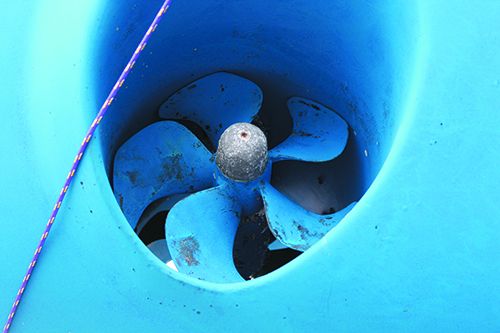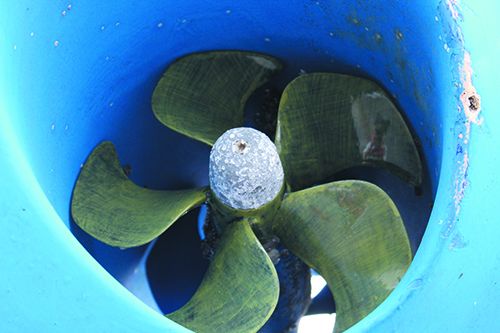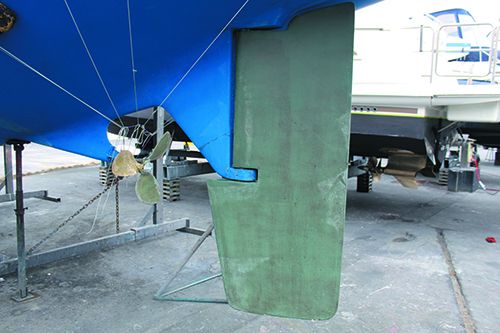I’ve been aware of Propspeed (a New Zealand product) for many years having been based in Auckland off and on since 1979. Propspeed, is a foul-release silicone coating famous for preventing marine growth on props and struts has always been produced in New Zealand, with reps in different countries.
During the South Pacific cyclone season we’d leave Mahina Tiare, our Hallberg-Rassy 46 in Half Moon Bay Marina’s dry storage facility while we returned to the United States. In April, prior to launching, BoatSpray, the boatyard’s painting company, would paint the bottom with antifouling. Each year, without fail, the manager would try to convince me to allow them to apply Propspeed. I’d decline, saying that we’d just snorkel down to scrub the prop with scrub brushes and 3M scouring pads.
One year we returned to discover that our then MaxProp was glistening with Propspeed’s yellowish silicone finish. When I asked why, BoatPaint’s manager said, “That’s a gift, mate! We know after having it for a season that you’ll be back for a recoat!”
Sure enough, after 10,000 miles of sailing through the South Pacific and returning to Auckland, we were convinced. In seven months we experienced almost no growth and only minor erosion of the coating at the blade tips.
I recently started seeing ads for PropGlide a similar, but less expensive product, made in the US. When I asked the owner of BoatSpray about PropGlide, he said the rep annually visits and that a few of his customers have requested it be applied.
The coatings are very similar, but PropGlide uses an acid etch called PropPrep, applied with a provided towlette. I thought it worthwhile to try testing both, so last April we coated two blades coated with Propspeed and one with PropGlide.
We sailed 10,000 miles during 30 weeks and at haulout, the Propspeed appeared to have been slightly more effective and adhered better.
The painting contractor proposed an additional test, so we had one of our two bow thruster props coated with Micron 77 and the other with Propspeed. The Propspeed did a far better job of preventing growth.
Coppercoat
Last year at the Pacific Boat Show in Richmond, California while making the rounds of the vendors, Amanda chatted with Jim, the very keen and knowledgeable US importer/distributor of Coppercoat.

difference in performance of Prop Speed and Micron 77.
Coppercoat is a water-based epoxy hull coating into which 98 percent pure copper powder is mixed in. It claims to have the potential of dramatically cutting pollution relating to antifouling paint and reducing costs of annual bottom painting. It rated Poor in a 2011 PS test (https://bit.ly/3ak0hq3), and has not been tested since.
HARD PAINTS at 20 MONTHS (FLORIDA)
| NAME | MAKER | PRICE/GAL | SPECIAL USES, COMMENTS | BOOSTER | COPPER/ ZINC** | LEACH RATE |
|---|---|---|---|---|---|---|
| Copper Pro SCX Hard | Blue Water | 215 | High copper, dual biocide | NCN | 0.67 | No data |
| EP2000 | Epaint | 290 | Water-based, race paint, alum.-safe, photoactive | ZnP | None | --- |
| SN-1 | Epaint | 275 | Freshwater release paint, fast finish | DCOIT | None | --- |
| ZO HP | Epaint | 325 | Photo-active high performance racing paint | ZnP 4.8% | None | --- |
| Ultra | Interlux | 190 | High copper, dual biocide | NCN | 0.55 | Category 1 |
| VC Offshore | Interlux | 260 | High-performance racing paint | None | 0.41 | Category 3 |
| Trinidad | Interlux | 225 | High copper | None | 0.76 | Category 1 |
| Trinidad SR | Interlux | 250 | High copper, dual biocide | PTFE | 0.65 | Category 1 |
| Woolsey Defense | Pettit | 95 | Standard hard, single season, high copper | None | 0.52 | No data |
| Sharkskin | Sea Hawk | 150 | Budget priced, single season | None | 0.45 | Category 1 |
| Tropikote | Sea Hawk | 250 | Multi-season, high copper | None | 0.76 | Category 3 |
If there is to be any motion in a green-paint direction, government policy will be the prime mover—but what policy will be most acceptable to the public remains unclear.
In 2005, the Port of San Diego, the U.S. Environmental Protection Agency, and the San Diego areas regional water-quality agencies pooled resources to research alternative antifouling paints. The study concluded that there were indeed several effective low-copper alternatives to bottom paints, and in 2015 the state’s Department of Pesticide Regulations then categorized the paints by leach rates, with Category 1 being the lowest leach rate (see tables above and below).
Despite implementing new restrictions prohibiting cleaning of hulls with “soft” bottom paints, the port was still not on target for meeting the 76-percent reduction by 2022 mandated by San Diego’s regional water commissions. An amendment that would further restrict bottom cleaning is currently undergoing review, although the most recent hearing was postponed
(https://bit.ly/3alwbCB).
Meanwhile in Washington State, a phasing out of all copper-based paints for recreational vessels, which was delayed from 2017 to 2021, is likely to be delayed again. The state’s own study (https://bit.ly/2uQLpk4) suggested that the chemicals introduced to replace copper needed more study, particularly with regards to their impact on the salmon fishery.
As of the printing of this issue of PS, the Washington state legislature appeared to be on target to passing a bill that would push the phase-out to 2025.
Nearly all of the top paints from Practical Sailor’s 2016-2018 long-term test fell below the California Department of Pesticides
threshold for Category 1 paints, the lowest leach rate. The leach rates for each category are as follows:
Category I: Products with a leach rate below or equal to (≤) 9.5 μg/cm2/day
Category II: Products with a leach rate below or equal to (≤) 13.4 and above (>) 9.5 μg/cm2/day 2
Category III: Products with a leach rate above (>) 13.4 μg/cm /day
ABLATIVE PAINTS RATED FAIR OR BETTER 20 AT MONTHS (FLORIDA)
| NAME | MAKER | PRICE | SPECIAL USES, COMMENTS | BIO-BOOSTER | COPPER/**ZINC | COPPER LEACH RATE |
|---|---|---|---|---|---|---|
| Gold Coast SPC Ablative | Blue Water | 155 | High copper, for high-fouling waters | ZnP 3% | 0.39 | No Data |
| Copper Shield Ablative | Blue Water | 120 | High copper, high fouling waters | ZnP 3% | 0.45 | No Data |
| Shelter Island Plus | Blue Water | 185 | Solvent based, copper free , zinc boosted | ZnP | Zinc 25% | --- |
| ZO | Epaint | 285 | Photoactive, alum. safe, harder finish | ZnP 4.8% | None | --- |
| Total Boat Inflatable (new) | Flexdel | $50/qt. | Flexible water-based for inflatable boats | ZO 2.9% | 0.28 | No Data |
| Total Boat Krypton (new) | Flexdel | 180 | Copper-free, single-season, with Econea | Econea 5.2 % | ZnP 4% | --- |
| Micron CF | Interlux | 220 | Multi-season, Copper-free Econea | Econea 3.9 % | NCN 2% | --- |
| Micron 66 | Interlux | 280 | Self-polishing copolymer, not for fresh water | ZnP 4.1% | 0.4 | Category 1 |
| Micron CSC $ | Interlux | 205 | High-strength, low VOC | None | 0.37 | Category 1 |
| Horizons | Pettit | 170 | Ablative multi-season | None | 0.48 | Category 1 |
| Hydrocoat Eco | Pettit | 225 | Water-based, copper-free with Econea | Econea 6% | Znp 4.8% | Category 1 |
| Ultima SR-60 | Pettit | 240 | Multi-season, dual-biocide | NCN 2% | 0.6 | No Data |
| Ultima SSA | Pettit | 130 | Single-season ablative paint | None | 0.38 | Category 1 |
| Woolsey Yacht Shield | Pettit | 175 | Multi-season, dual biocide, high-copper | NCN 2% | 0.4 | Category 1 |
| Vivid | Pettit | 240 | Bright colors, white ZnP | ZnP | 0.25 | Category 1 |
| West Marine CPP* | Pettit | 140 | Uses composite copper technology | None | 0.38 | Category 1 |
| West Marine PCA Gold* | Pettit | 210 | Industry standard with biocide | NCN 2% | 0.4 | Category 1 |
| Biocop TF | Sea Hawk | 275 | Dual-biocide, multi-season | ZnP 4.5% | 0.38 | No Data |
| Cukote | Sea Hawk | 200 | High copper | None | 0.48 | Category 2 |
| Smart Solution | Sea Hawk | 190 | Metal-free, slick-film racing paint | Econea 2.9% | None | --- |
Simultaneously at the show we met Quincey and Mitchell, a young couple who purchased a Peterson 44 that had 30,000 tropical miles on the Coppercoat underwater coating which had been originally applied professionally 12 years earlier in New Zealand. They showed us photos of their hull which they’d recently hauled, and told us that they were purchasing kits to recoat a couple of small areas that were starting to foul. They mentioned that as far as they knew, this was the first time in 12 years the Coppercote had been re-touched, other than scrubbing and pressure washing.

although it is comparable to Interlux Micron 66, sold in the U.S.
As I’m always searching for the best antifouling coating I asked BoatSpray if they could coat our rudder. Brian Kent, current manager of BoatSpray said that since the importer/distributor of Coppercoat had recently come to the yard to do several Coppercoat coatings, he’d prefer to have him apply it to ensure we’d be starting with the best possible coverage.
The US-importer stresses that it is critical to sand the water-based epoxy after it has cured, enabling the copper, not the epoxy to be in direct contact with the seawater.
Once the Coppercoat was applied by the distributer and cured, we sanded the starboard side fairly aggressively, in accordance with the attached sanding instructions, until it was nearly free of dimples. The port side was sanded lightly.
Our results after 10,000 miles and 30 weeks was that a substantial amount of slime would occur on the rudder. The port side fared well, but by midseason the starboard side had numerous barnacles adhering to it.
Without a doubt, the Coppercoat coated rudder required more frequent sponging or scrubbing than the Micron 77 coated hull. PS contributors Patrick and Rebecca Childress noted that the guidelines for application were hard to match, and this may have impacted performance (see https://bit.ly/3agsuOo). In our case, the starboard side was sanded very aggressively to match the photographs indicated in the US distributors guidelines. The cleaner, port side was not sanded as aggressively.
<stro
As we’re now recoating the starboard side of the rudder I’m curious to see how many years it would take for the cost of Coppercoat to beat the cost of Micron.
Amanda and John Neal spend seven months at sea sailing 10,000 miles a year while leading sailing training expeditions. The have more than 750,000 sea miles combined experience.


































What about Hemple’s Silic-One
I’ve never heard of it before your post so I googled it does sound attractive. I would like to see how well this coating would work but unless there was a retailer for my location it’s not much good to me (Canada).
Do you have any experience with it?
I am about to do my Southern Cross 39 bottom. I have a fair quantity of powdered Copper I plan to use.
I have heard everything from “buy the cheapest bottom paint you can find and mix with the powder steadily while applying to put a hard Barrier coat on the Gel Coat and mix the copper in Epoxy and apply on top of the Barrier Coat. Finally put your ablative on top of that.
Any words of wisdom are well appreciated. I am in Australian waters and there is a lot of things in these waters that make me want to stay out of it while here….Thanks
I don’t see any Petit paints. Anyone have experience with Petit Odyssey Triton?
Oops, I didn’t see the mfg column.